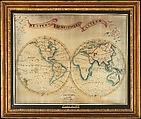Map sampler made at Pleasent Valley Quaker Boarding School
Polly Platt American
Map samplers worked by schoolgirls emerged in Britain during the late eighteenth century. The tradition eventually spread to North America, though it was not practiced with the same frequency as in Britain. Map samplers originated from maps printed on paper that could also be printed on textiles for girls and young women to embroider and embellish. The double hemisphere map of the world was a printed image that could be marketed to schools in the United States as well as in Britain, highlighting the two countries’ cultural and pedagogical ties.
This sampler is a fine example of those produced by students at the Pleasant Valley Quaker boarding school in New York in the first quarter of the nineteenth century. The school’s three Quaker founders, Ann Shipley, her daughter-in-law Phebe Shipley, and her niece Agnes Abbatt Dean, had family connections to Quaker schools in England where map samplers had evolved in the teaching of geography. In the school’s first advertisements, the founders specified the teaching of "geography, working [i.e. embroidering] maps, the use of globes, &c." The strong similarity between Pleasant Valley double hemisphere map samplers, including this one, and those from English schools suggests a common print source. "An Outline of the Map of the World for Ladies Needlework and Young Students of Geography," published by R. Laurie and J. Whittle in 1798, is one candidate.
The inscription located between the hemispheres: "Polly Platt / Athens / July 20 1809" suggests the maker to be a woman named Mary (Polly) Platt, born in New York in 1795. She had grandparents who lived in Pleasant Valley, which might be why the young girl attended school there. Additionally, this sampler retains its original frame (and original reverse painted glass), and is backed with its the original pink, gray, and black diamond pattern wallpaper. On the wallpaper backing appears a label from the New York City framer Isaac L. Platt (1793-1875). The label advertises Platt as a "Looking-Glass & Print Seller and framer of … needlework, drawings, &c." at his 196 Broadway address where he worked from 1815 to 1818. Records show that Isaac and Polly were cousins.
Due to rights restrictions, this image cannot be enlarged, viewed at full screen, or downloaded.

